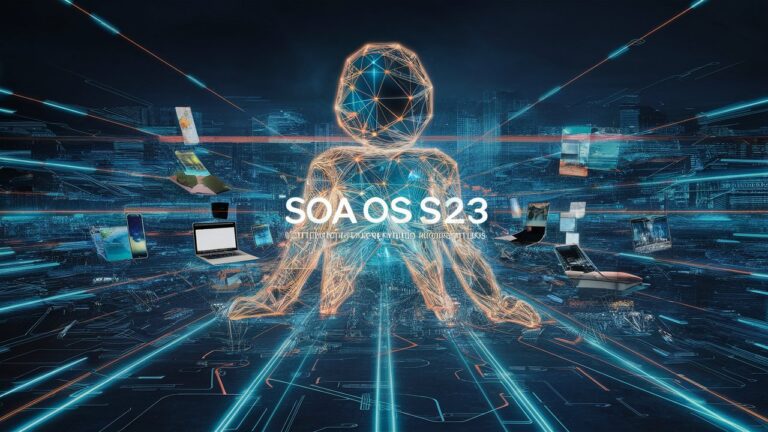Introduction
In the rapidly evolving landscape of software and systems engineering, traditional paradigms strain under the weight of complexity, AI integration, compliance pressures, and distributed computing demands. SOA OS23, an emergent conceptual framework, reinterprets Service-Oriented Architecture for this moment. It’s not a software product or operating system, but rather a living, adaptive architecture—one where services are semantic actors, orchestration is event-first and context-aware, and policy, ethics, and human agency are embedded at every layer.
Core Concepts of SOA OS23
Event-First Logic
In contrast to request-response models, SOA OS23 thrives on continual events—sensor alerts, UI gestures, data triggers—that ripple across the system. Services subscribe, respond, and evolve based on a fabric of ambient signals, enabling systems to anticipate and adapt in real time.
Cordless.io
Context-Aware Service Mesh
Beyond naive load-balancing, SOA OS23’s mesh understands why a service is summoned—considering user state, regional compliance, device modality, and even service health. This prevents misrouting and fosters intelligibility.
Cordless.io
Human-in-the-Loop Interfaces
Instead of isolating automation, SOA OS23 reinstates human agency in critical workflows—especially in sectors like healthcare or finance—allowing decisions to be paused, redirected, or contextually enriched.
Cordless.io
Semantic Interoperability
Data schema is no longer enough. Services speak meaning. AI-powered translation layers mediate between differing taxonomies, languages, or legacy formats, ensuring deep interoperability—not just syntactic compatibility.
Cordless.io
Modular Compliance & Ethics Engines
Every service carries its own metadata—permissions, retention rules, auditability, regional constraints—turning governance from an add-on into a structural feature.
Cordless.io
Why SOA OS23 Matters Now
-
Overload of Complexity: With systems spanning cloud, edge, AI, IoT, and decentralized networks, static models crumble under scale. SOA OS23 offers composable resilience.
-
AI-First Systems: The need for orchestration among machine learning, humans, APIs, and dynamic UIs calls for architectural sensitivity, not monoliths.
-
Regulatory Strain: In a world of GDPR and emerging AI legislation, policy-aware architecture is critical for adaptability.
-
Philosophical Shift in Engineering: Modern developers demand systems that reflect values—transparency, ethics, adaptability, sustainability. SOA OS23 responds.
Cordless.io
Architectural Blueprint
-
Layer 1: Sensor & Interface — converting gestures, clicks, data into structured events.
-
Layer 2: Orchestration Mesh — semantic-aware routing.
-
Layer 3: Ethics & Policy Engine — evaluating compliance before execution.
-
Layer 4: Service Repository — modular, versioned, and hot-swappable services.
-
Layer 5: Intelligence Layer — AI mediates, predicts, and explains decisions.
Cordless.io
Applications in the Real World
Healthcare: Wearables feed data; privacy is enforced per jurisdiction; AI recommends treatment; humans validate; billing is calculated—all with audit trails.
Smart Cities: Traffic, energy, signals, and alerts coordinate via ambient events—supporting lights, pollution control, and emergencies—across vendor-agnostic platforms.
Cordless.io
Challenges & Criticisms
This approach brings complexity in metadata, observability, and system transparency. Human-in-the-loop systems must avoid introducing bottlenecks or fatigue. Architectural discipline is critical.
Cordless.io
Conclusion
SOA OS23 may be a conceptual shift, but it signals a deeper change in how we design systems—not as static blueprints, but as ethical, responsive, living architectures. In the era of automation and overload, systems that can think, adapt, explain, and feel—however imperfectly—may offer the most human-centered approach of all.
Frequently Asked Questions (FAQ)
-
What is SOA OS23?
A modern architectural philosophy—not a product—that combines event-driven orchestration, AI, governance, and context-aware design for today’s complex digital ecosystems.
Cordless.io -
How does it differ from classic SOA or microservices?
It goes beyond modularity, adding context-awareness, regulatory intelligence, semantics, and human interaction at the service layer.
Cordless.io -
Why is this relevant now?
The interplay of AI, regulatory pressures, and system fragmentation demands a more sophisticated, adaptive architecture.
Cordless.io -
Is SOA OS23 a formal standard or software?
No—it’s an architectural mindset, a design philosophy integrating AI, policy, event orchestration, and human feedback loops.
Cordless.io -
What benefits does it offer?
-
Context-aware real-time orchestration
-
Built-in compliance and ethical layers
-
Flexible, modular services
-
Human oversight where needed
-
Resilience and transparency in complex systems
Cordless.io
-
